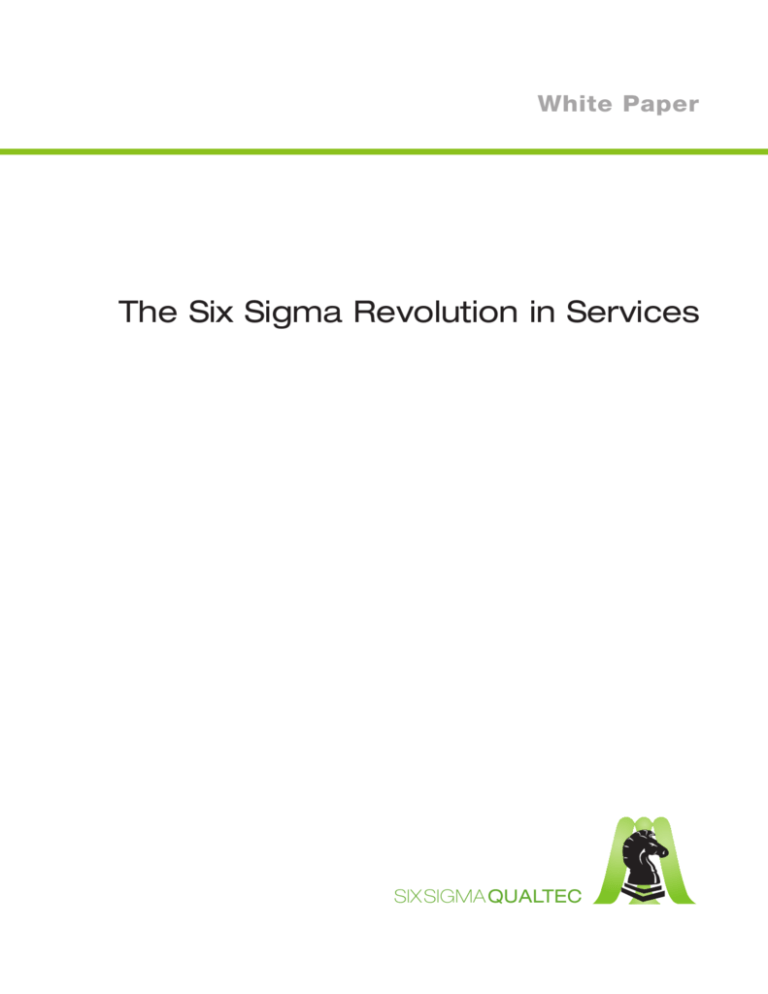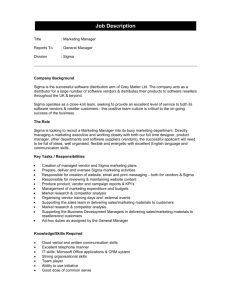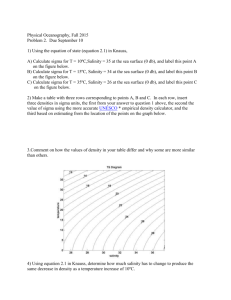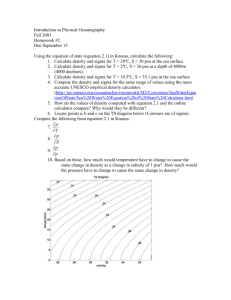
White Paper
The Six Sigma Revolution in Services
SIX SIGMA QUALTEC
WHITE PAPER
The Six Sigma Revolution in Services
The Six Sigma Revolution in Services
A White Paper By Zachery Brice
Six Sigma Qualtec
Six Sigma is increasingly transforming service industries. Since this revolutionary approach to quality was first
developed at Motorola, refined at Allied Signal, and became the stuff of legend at G.E. under Jack Welch, it has
spread throughout service industries like outsourcing, financial services, and telecommunications.
At first blush, Six Sigma, originally designed to perfect manufacturing processes that were already highly engineered, might seem ill-suited to services, where processes aren’t engineered at all. But that’s precisely the point.
Because many service businesses have never analyzed their business processes, they often suffer from inflated
costs and poor customer service.
From Task to Process
The initial insight about the wider applicability of Six Sigma was born at GE. The company understood
that Six Sigma techniques could be applied to any process that resulted in defects, whether the defects were
faulty products, financial transactions, or business processes. GE soon expanded Six Sigma to its service
businesses, such as GE Financial.
The heart of every service-based business depends on the opinions, behaviors, and decisions made by people operating through work processes, whether the processes are recognized or not. Analyzing and modifying human performance in these environments is as complex as any manufacturing situation. Nevertheless,
most services companies take a task focus: sell more mortgages, sign up more wireless customers, get a call
center up and running. Six Sigma brings a process focus: streamline mortgage approval procedures,
improve customer service processes to retain wireless customers, analyze customer problem resolution.
Financial Services
Six Sigma has swept through financial services, where performance management has become critical for
firms throughout the sector. From retail and commercial banking, to credit cards, mortgage origination and
servicing, investment banking, and insurance, the pressure to remain responsive to customer demands
increases daily. Customers expect faster, easier service at every channel, every location, and every point of
contact – and if they don’t get it they will go elsewhere in a heartbeat.
The economic boom of the nineties strained the capacity of many lending institutions to originate, close,
and service loans quickly enough to meet customer demand. As a result, they thought long and hard about
how they might improve the cycle times of all their processes, break bottlenecks, minimize errors, cut costs,
increase capacity, and delight customers. They discovered that figuring out how to provide more value per
customer transaction, rather than how to acquire more transactions, leads to market leadership, and delighting existing customers can be more important than finding new ones. It soon became apparent that this
intense focus on customer satisfaction leads to top-line growth and drives greater shareholder value.
© 2006 Six Sigma Qualtec. All Rights Reserved.
1
WHITE PAPER
The Six Sigma Revolution in Services
Employing the Define, Measure, Analyze, Improve, Control (DMAIC) methodology of Six Sigma, leading
financial services organizations have worked diligently to become error-free when they handle the customer’s
money, process payments, send out bills, close a loan, collect outstanding debts, or answer the phone.
For example, the International Private Banking (IPB) division of one of the world’s largest banking and
financial services companies faced increasing customer dissatisfaction as a result of inefficiencies in its
international wire transfer operations. Remember that these customers constitute a strategically important
customer base: they are highly profitable and their relationships extend into many other lines of business.
These inefficiencies greatly increased the bank’s annual wire processing costs, some of which the bank,
unlike its competition, passed along to customers through transaction fees – despite the bank’s own surveys
identifying fees as one of the most important concerns of its customers.
The international wire transfer process was redesigned using Six Sigma methodologies to eliminate the
errors, customer callbacks, transfer delays, and transfer fees that inconvenienced customers and contributed
to high rates of customer churn. Transfer cycle time was slashed 46%, which, coupled with an extended
cut-off time for making transfers, has all but eliminated delayed wires. This increased efficiency, by slashing the cost per payment order more than 50%, has also enabled the IPB to waive its transaction fees entirely, further improving customer satisfaction. In addition to helping the bank retain valued customers, the
improvements could save the bank nearly $1 million in annual savings. As importantly, the company has
improved its reputation for being easy to deal with.
A leading mortgage banking firm provides another example of how Six Sigma drives customer satisfaction
and ultimately increases market share and growth. The bank, whose clientele includes many borrowers who
have been disqualified from traditional loan sources, wanted to improve customer satisfaction and increase
investor confidence. In addition to establishing a CRM initiative, the firm introduced Six Sigma quality into
key business processes through targeted training of in-house Six Sigma experts to lead critical process
redesign projects. Once trained, they not only addressed customer and investor issues, but also produced
significant and unanticipated increases in revenue and reductions in costs.
The lender improved customer satisfaction by improving customer response time by 350%, reducing abandoned customer call rates from 12% to 4%, and eliminating process redundancies by 66%. At the same, an
increase in loan retention of 20% and the elimination of $21 million in risk exposure boosted investor confidence. Together these improvements are saving the company some $5.5 million annually and generating
additional revenues of $1 million.
Telecommunications
Following that solid record of success in financial services, the next Six Sigma revolution is likely to take
place in telecommunications. Both the telecommunications equipment sector and the telecommunications
services sector of the industry have been badly battered in recent years. Total spending on equipment fell by
about 15% in 2001 and fell another 20% in 2002. Long-haul optical networks now operate at below half of
their capacity. Until sales of core wireline equipment pick up, manufacturers in the US and Europe also
face the challenge of developing new products to deliver data and voice traffic from long distance networks
to broadband customers in urban areas. The mobile communications segment is also changing as exhaustively hyped mobile data services and the tide of third generation wireless technology arrive.
In the telecommunications services sector in the late 1990s, the word was: "Build it and they will come."
Following passage of the Telecommunications Act of 1996, the telecom sector rode the high-tech current of
an economic expansion that, in retrospect, appears to have been built on blind faith. In the five years that
followed passage of the 1996 legislation, the telecom industry received $1.3 trillion from investors, and has
since lost more than $1 trillion in market value.
© 2006 Six Sigma Qualtec. All Rights Reserved.
2
WHITE PAPER
The Six Sigma Revolution in Services
For telecommunications equipment and services, short- and long-term success depends on excelling in
operational focus, financial discipline, and opportunistic growth. Six Sigma can help with all three. A sampling of highly focused projects begins to suggest the enormous potential of applying Six Sigma even more
widely across the numerous functions and processes on which telecommunications companies depend:
Increasing sales force availability for customers in emerging markets: Relentless competition in telecommunications requires an account team that can assess customer needs and submit quotes quickly. Nevertheless,
Six Sigma analysis found that salespeople in the emerging market for a telecommunications provider spent
on average some 52% of their time in non-value-added activities such as travel, meetings, and customer
service issues – despite the fact that the company was depending on increased sales force productivity to
weather the economic downturn and industry turmoil.
Six Sigma analysis uncovered statistically and economically significant relationships between the time
spent on non-value-added activities and (1) the geographic layout of a salesperson’s territory, (2) whether
they set their own customer appointments or had appointments set for them, and (3) the level of their time
and territory management skills. The company addressed all three factors by setting up a special call center
team to set appointments for salespeople and developed a process for route management that enabled the
team to prioritize appointments in the most geographically efficient way. As a result, salespeople now
spend far more time in front of prospective customers, save money on travel, and spend far less time in
non-value-added activities – increasing annual sales by nearly $1 million.
Reducing the sales to cash interval: As a PBX dealer/distributor’s selling model shifted to resale, the company needed to more accurately forecast and to accelerate customers’ payments after installation in order to
reduce exposure to creditors. The sales to cash interval averaged four months, whereas reducing it by only
one month would save $550,000. However, the company’s sales to cash process is complex, with numerous
interdependencies that can cause excessive delay. A Six Sigma team found that the longest interval under
direct control is the time from installation to posting of the invoice. The average time stood at 18.3 days,
costing the company $420,000 annually in delayed revenue.
Focusing on this critical interval, the team developed a data base to track an order through its entire life,
created tools for process operators to monitor overdue orders, modified the process for more direct operator
communication, and developed a means for regular process control review and discussion. The interval was
reduced by 7.5 days, which will result in annual savings of $420,000. In addition to increasing the accuracy
and timeliness of customer billings, improving forecasting accuracy, and reducing internal costs, the project
led to modifications in setting customer expectations and paved the way for an improved collections process.
Reducing business market collections: A telecommunications provider, focused on generating sales revenue
in its business market, performed poorly when it came to collecting that revenue. A preliminary analysis by
a Six Sigma team determined that 60% of billed revenue, or approximately $25 million, went 60 days past
due every month – jeopardizing the company’s objective to achieve positive cash flow by the end of the year.
Combining powerful Six Sigma analytical tools and Business Process Management, the team’s program to
reduce the ‘defects’ in the collections process included reprioritizing collections work, assigning collections
representatives to strategic accounts, conducting collections ‘blitzkriegs’, stopping the high turnover in the
collections manager position, and implementing a new call strategy. The project reduced by almost 18% the
total past due greater than 60 days, increasing revenue by $2.4 million.
These necessarily narrow examples touch on only a few of the many processes and functions that telecommunications entails. From maintenance, procurement, and operations to customer care to sales to reducing
cycle time, cost-per-transaction, and duplications, Six Sigma is likely to make an enormous difference in
customer satisfaction, revenues, and costs. And as Six Sigma spreads to more and more of those functions,
the impact will grow exponentially.
© 2006 Six Sigma Qualtec. All Rights Reserved.
3
WHITE PAPER
The Six Sigma Revolution in Services
Succeeding with Six Sigma in Services
Successfully implementing Six Sigma in services businesses requires a relentless focus on customers and on meeting their needs as efficiently as possible. It entails four critical steps:
Define what is critical to your customers and confirm that your core processes are aligned to
those requirements. As the term ‘services’ implies, you must understand your customers’ needs before
you can serve them. Find out what those needs are. There are many ways to uncover those needs – through
surveys, call center results, focus groups, promotional campaigns – whatever means allows the voice of the
customer to be heard loudly and clearly. At the same time, you must understand the key business issues for
your company and align the voice of the customer with them.
Translate customer requirements into measurable characteristics of your processes. Once you
understand customer requirements you must be able to measure the effectiveness and efficiency of your
processes in fulfilling those requirements. Effectiveness addresses the problem of ‘defects’ that your
processes produce; efficiency addresses the time and money that the processes consume in meeting customer needs. A high rate of defects or time and money wasted in non-value-added activities increases your
cost-per-transaction. The formula for translating customer requirements into measurable characteristics is
simple: ‘as measured by.’ For example, if on-time delivery is important for your customer, then the metric
would typically be ‘on-time delivery as measured by the time from the promised date to the date of actual
fulfillment.’
Quantify the impact of particular gaps in your processes in terms of the cost of poor quality (COPQ). For
example, a mortgage lender whose customers want fast action on their applications might find that the
process includes a high number of abandoned calls by customers, long delays in producing a quote that
cause prospects to drop out, and numerous inaccurate credit reports. The Six Sigma methodology includes
powerful tools for analyzing each of those gaps and quantifying what that poor quality is costing the
company in each case.
Prioritize improvement projects. Once you clearly understand what each process gap is costing you, you
can prioritize your improvement efforts according to what is most critical to you – customer service, time,
money, perceived value, and other criteria. Because improvement in any organization proceeds project by
project, you must be sure that you are investing your effort in the right projects in the right order.
Above all, you must continue to look at your business through the eyes of the customer. It is possible – and
pointless – to redesign your internal processes and never touch the real needs of the customer. That doesn’t
mean remaking your processes with the customer only in mind. You must also remember the voice of the
stakeholder and make sure that your customer-pleasing processes also meet the critical needs of your business.
Six Sigma provides a powerful means for keeping those sometimes competing voices in perfect harmony.
© 2006 Six Sigma Qualtec. All Rights Reserved.
4
WHITE PAPER
The Six Sigma Revolution in Services
Wireless handset case
Beyond Remedying Defects to Fulfilling Business Needs
If Six Sigma isn’t just for manufacturing anymore, it isn’t just for remedying defects either. It can also be
applied proactively to fulfill a pressing business need. The wireless telephone business provides a case in
point. Although the business has grown phenomenally over the past six years, it is now maturing. To maintain
profitable growth it has become increasingly necessary to acquire high-value customers as cost-effectively
as possible. To maintain its competitive edge, a regional telephone company decided to try to slash its Cost
per Gross Add (CPGA) of a new wireless customer.
Through process mapping of the entire sales cycle, a Six Sigma team determined that the greatest opportunity
for reducing CPGA lay in the costs of upgrading and replacing customers’ malfunctioning handsets
(Figure 1). The team zeroed in on the upgrade and exchange process, uncovering key areas where problems
were likely to increase costs in returns and exchanges (Figure 2). It was at this point that the team applied
such highly statistical Six Sigma methodologies as Pareto analysis to identify process capabilities and
develop a program for improvement. The team broke return/exchanges into three classes based on whether
the return occurred less than 30 days after the sale, more than 30 days to a year, and more than a year,
which allowed them to pinpoint improvements in each of these circumstances.
The improvements included working more closely with the handset manufacturer, working with retailers to
improve their internal processes, insisting on compliance with return/exchange policy, automating some key
processes to eliminate errors, and re-educating customers on how best to handle issues with handsets. As a
result of these efforts, the team drove out over $236,500 in expenses annually.
High Level Sales Process Map
Figure 1: Process mapping uncovers upgrade as site of greatest business pain.
© 2006 Six Sigma Qualtec. All Rights Reserved.
5
WHITE PAPER
The Six Sigma Revolution in Services
Figure 2: Drilling down into the handset return/exchange process.
© 2006 Six Sigma Qualtec. All Rights Reserved.
6
Six Sigma QualtecSIX SIGMA QUALTEC
Your Strategic Partner
Six Sigma Qualtec is a premier provider of process management and performance
improvement consulting, training, and technology solutions that drive breakthrough
growth, productivity and value for our clients.
We are unique in our ability to customize the integration of management disciplines
to meet the industry-specific requirements of global leaders in financial services,
natural resources, manufacturing, process and service industries.
Six Sigma Qualtec
821 Alexander Road
Suite 130
Princeton, NJ 08540 • USA
Six Sigma Qualtec
1295 W. Washington Street
Suite 208
Tempe, AZ 85281 • USA
toll free
phone
fax
email
website
toll free
phone
fax
email
website
(800) 247-9871
(609) 925-9458
(609) 419-9855
info@ssqi.com
www.ssqi.com
© 2006 Six Sigma Qualtec. All Rights Reserved.
(800) 247-9871
(480) 586-2600
(480) 586-2586
info@ssqi.com
www.ssqi.com
Six Sigma Qualtec
P.O. Box 2959
Kenilworth
CV8 1XR
United Kingdom
tel
fax
email
website
+44 (0) 1926 859555
+44 (0) 8701 400023
info@ssqi.co.uk
www.ssqi.co.uk







